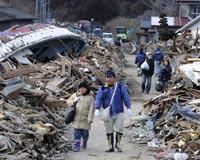| . |  |
. |
Tokyo (AFP) April 14, 2011 Japanese police on Thursday found the bodies of 10 tsunami victims in the first search of a 10-kilometre (six-mile) zone around an atomic plant, as emergency crews battled to contain a nuclear crisis. Hundreds of police wearing white protective suits and face masks scoured rubble-strewn neighbourhoods near the plant for victims of the giant wave that smashed into Japan's northeast coast more than a month ago. Some of the remains were found inside cars and others were "buried in debris, so that the sight of just a foot or other body part would lead to the discovery of a whole body," a Fukushima police spokesman told AFP. The 300-strong force was to continue their search Friday in the no-man's land -- pushing closer towards the facility after they started a wider search on April 3 that covered the outer areas of the 20-km exclusion zone. Before the search began, police said it was difficult to estimate how many bodies were in the 10-kilometre danger zone around the plant, although the Yomiuri Shimbun newspaper put the figure at around 1,000 tsunami victims. At the plant itself, emergency crews continued efforts to stop radioactive leaks into the Pacific, erecting a seabed silt fence to slow the spread of contaminants to sea and pumping highly toxic runoff water into tanks. Plant operator Tokyo Electric Power Company (TEPCO) said it was also analysing footage taken by an unmanned helicopter of the tsunami-hit plant and its explosion-charred reactor buildings to assess the damage. A probe of the reactor four containment pool for more than 1,000 fuel rods -- exposed to the sky after a hydrogen blast ripped away the roof -- suggested that some of the rods had been damaged, but that most were intact. Plant workers kept pumping highly toxic runoff water from dousing operations into special tanks, so that they can safely resume the long-term work to restore the plant's original cooling systems and shut the plant down. Worries lingered over the impact of radioactive spills on marine life after the health ministry said caesium levels 25 times the legal limit had been detected in young sand lance caught off Fukushima prefecture. One sample of the tiny fish, whose sale has been halted since last week, had a caesium level of 12,500 becquerels per kilogram (5,680 per pound), far exceeding the 500 becquerel limit, Kyodo News reported. New figures showed the crisis has also hit tourism hard, with the number of foreign visitors to Japan suffering its biggest ever decline in March. Just 352,800 foreigners arrived in Japan, the government said -- half the figure for March 2010. Emperor Akihito meanwhile made his first trip to a disaster-hit area, visiting a shelter in Chiba prefecture for evacuees from the calamity that killed 13,498 people and left 14,734 missing by the latest count. Around 150,000 people are still living in shelters and the number is expected to swell after authorities this week declared new areas off-limits due to concerns over the effect of long-term exposure to radiation from the plant. A 102-year-old man from Iitate -- one of the areas added to the evacuation zone -- committed suicide, reportedly depressed at having to leave his home. Prime Minister Naoto Kan told the first meeting of a reconstruction panel that he wanted to rejuvenate the disaster area to make it into one of the world's most desirable places to live. Kan is considering developing an environmentally friendly inland town with a population of 50,000-100,000, Kyodo News reported after the meeting of architects, academics, government and business leaders. But even as the panel looked at the future, with plans to create a plan by June, the political infighting of the pre-disaster past resurfaced, over a month after the massive quake struck. Opposition leader Sadakazu Tanigaki, the head of the conservative Liberal Democrats, suggested Kan think about resigning, while sniping also resumed from inside Kan's centre-left Democratic Party. "To continue under the current leadership would be extremely unfortunate for the people," Tanigaki said, also hinting at launching no-confidence motions against Kan's cabinet in both houses of parliament.
Share This Article With Planet Earth
Related Links Bringing Order To A World Of Disasters A world of storm and tempest When the Earth Quakes
 Japan can pay for rebuild: central bank governor
Japan can pay for rebuild: central bank governorNew York (AFP) April 13, 2011 Japan's economy suffered a big blow in the triple earthquake, tsunami and nuclear disaster, but the country should have no problem financing reconstruction, the central bank chief said Thursday. Bank of Japan Governor Masaaki Shirakawa conceded problems in the economic supply chain, power generation, tourism and other important sectors. But he said the financial system could cope. "A ... read more |
|
| The content herein, unless otherwise known to be public domain, are Copyright 1995-2010 - SpaceDaily. AFP and UPI Wire Stories are copyright Agence France-Presse and United Press International. ESA Portal Reports are copyright European Space Agency. All NASA sourced material is public domain. Additional copyrights may apply in whole or part to other bona fide parties. Advertising does not imply endorsement,agreement or approval of any opinions, statements or information provided by SpaceDaily on any Web page published or hosted by SpaceDaily. Privacy Statement |